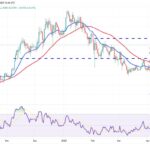In a fluctuating market marked by global uncertainties, Bitcoin (BTC) has shown resilience, trading just below the $95,000 mark with a modest 0.5% gain over the past 24 hours. Recent macroeconomic indicators have cast a shadow over investor sentiment, yet the leading cryptocurrency has managed to retain its ground amidst the turbulence. The CoinDesk 20 index, which tracks the performance of the top cryptocurrencies excluding specific categories, remained largely unchanged during this period.
On Wall Street, cryptocurrency-related stocks like Coinbase (COIN) and MicroStrategy (MSTR) faced slight declines following significant rebounds last week. However, some companies such as Janover (JNVR) and DeFi Technologies (DFTF) bucked the trend, posting impressive gains of 24% and 6.5%, respectively, even as their preferred token, SOL, experienced a dip of about 3% during the U.S. trading day.
“Pretty horrible Dallas Fed Manufacturing Survey. Level hits the lowest since May 2020,” noted Joe Weisenthal, co-host of the Odd Lots podcast, reflecting concerns over economic stability.
The recent dismal report from the Dallas Fed Manufacturing Index, plunging to -35.8 from -16.3, significantly deviated from analysts’ expectations and suggests a worrying outlook for the economy; it marks the weakest performance since the onset of the COVID-19 pandemic. This drop was compounded by heightened geopolitical tensions, particularly between India and Pakistan, as reports surfaced regarding potential military escalations in the region.
In contrast to the cryptocurrency market, traditional assets like gold saw a nearly 1% increase, while the U.S. dollar index fell by 0.6%. Stock indices, including the S&P 500 and Nasdaq, experienced a late-session recovery after earlier losses of over 1%. As the financial world reacts to these diverse influences, the interplay between cryptocurrencies and traditional markets continues to evolve in intriguing ways.

Bitcoin Market Overview and Economic Impact
This summary highlights the key points regarding Bitcoin’s performance amidst ongoing macroeconomic developments and geopolitical tensions, and their potential impact on readers’ lives.
- Bitcoin Stability
- Trading just below $95,000, Bitcoin saw a modest increase of 0.5% in the last 24 hours.
- This resilience amidst negative macroeconomic news may influence investor confidence.
- Crypto Stocks Performance
- Major crypto stocks like Coinbase and Marathon Digital experienced slight declines.
- Notable exceptions included Janover and DeFi Technologies, which saw gains of 24% and 6.5%, respectively.
- These fluctuations may affect retail investors’ decisions on asset diversification.
- Macroeconomic Indicators
- The Dallas Fed Manufacturing Index plummeted to -35.8, significantly worse than expectations.
- This drop raises concerns about potential economic recession, impacting consumer spending and investment strategies.
- Geopolitical Tensions
- Increased military tensions between India and Pakistan could create additional market volatility.
- Such conflicts may affect energy prices and investment sentiment, ultimately impacting your daily expenses and financial planning.
- Gold and Dollar Performance
- Gold prices rose by almost 1% while the dollar index fell by 0.6%.
- This could signal a shift in investor preference towards traditional safe-haven assets amidst uncertainty.
“All the comments are about tariffs and policy uncertainty. Add it to the list of bad soft/survey data.” – Joe Weisenthal
Understanding these dynamics can provide readers with insights into making informed financial decisions in an uncertain market landscape.
Bitcoin’s Resilience Amidst Economic Turbulence: A Comparative Analysis
In the ever-volatile landscape of cryptocurrency, Bitcoin (BTC) demonstrated notable resilience recently, sustaining its position just below $95,000 despite a backdrop of unfavorable macroeconomic news. This contrasts sharply with other financial assets, drawing a parallel with the performance of traditional markets and commodities. For instance, while Bitcoin managed to gain slightly in a tumultuous trading environment, gold experienced a modest increase of nearly 1%, showcasing its safe-haven appeal amid economic uncertainties.
When looking at the broader cryptocurrency landscape, Bitcoin’s relatively stable trajectory stands out against the backdrop of the CoinDesk 20 index, which remained largely stagnant. This scenario may suggest a competitive advantage for Bitcoin, positioning it as a more stable option amidst fluctuations seen in other cryptocurrencies. However, the performance of crypto stocks like Coinbase and MicroStrategy, which experienced slight declines after significant gains, indicates that investor sentiment may be souring in the face of macroeconomic data such as the jolting Dallas Fed Manufacturing Index, signaling potential industry-wide challenges.
While Bitcoin benefits from its reputation and investor loyalty, companies like Janover and DeFi Technologies, which reported impressive gains, suggest that there is still room for growth within specific niches of the cryptocurrency market. Their focus on accumulation strategies, particularly with tokens like SOL, highlights an innovative approach but also emphasizes the risk of being tethered to a volatile asset. For investors in these companies, the current climate is a double-edged sword—potential for high returns might be shadowed by significant market volatility, further complicating investment decisions.
The rising hostilities between India and Pakistan only contribute to market jitters, stirring additional anxiety among investors. While geopolitical tensions typically decrease risk appetite across the board, Bitcoin’s performance could sway those looking for alternatives outside conventional markets. Crypto enthusiasts and risk-tolerant investors might find opportunities amid these risks, leveraging Bitcoin’s current stability as a hedge against geopolitical and economic uncertainty. However, traditional investors heavily reliant on stability may find the circumstances creating friction within their portfolio strategies.
In essence, Bitcoin’s steadfastness amidst this turbulence opens avenues for both opportunity and risk, potentially drawing in new investors looking to capitalize on market fluctuations while presenting challenges for traditional investments facing headwinds from economic indicators and geopolitical tensions.

















